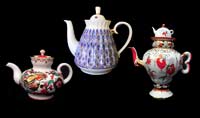History of Lomonosov Porcelain Factory (LFZ)
Leading Russian porcelain factory was founded in 1744 by Empress Elizabeth, the daughter of Peter the Great. Russian scientist Dmitry Vinogradov independently discovered the secret of making porcelain and developed the technology for its manufacture. It is necessary to say that in that time secret of porcelain was known only to Chinese crafters. Only Saxon alchemist J. Bottger discovered a way to produce "European" hard paste porcelain. Peter the Great who visited European countries and followed all modern inventions was interested in the secrets of porcelain manufacture. He made an attemption to introduce it to Russia with the help of foreign crafters, but unsuccessfully. Peter I's idea to establish own porcelain production had success after his death. His daughter Empress Elizabeth (1741-1761) hired scientist Dmitry Vinogradov who used local raw materials - Gzel clays and Olonets quartz and alabaster. Credit is also to D.Vinogradov for training the first the first Russian master craftsmen of porcelain manufacture.
.The factory belonged to the House of Romanov and it produced tableware and other porcelain pieces only for Russian Tsar court. Later in middle of 19 century the factory was renamed to "The Emperor's Porcelain Factory". The Factory supplied the needs of the Tsar's Court and, as compared to private porcelain works, was a small-scale production. The article produced were extremely costly and were very rarely put up for sale.
On the occasion of the centenary of the factory's foundation a museum of porcelain-ware was opened, which comprise now 20,000 items reflecting the evolution of artistic porcelain production. Items manufactured in period from 1750 to 1820, when prominent masters from the Academy of Arts participated in the designing and decoration of the porcelain, are of particular interest. LAter the links between the Factory and the Academy of Arts decreased abruptly and the artistic quality of the articles and the technology of their production deteriorated.
In the early 19 century the Factory reconstructed and the manufacture of complex and large-size porcelain pieces was initiated.
In 1915, in connection with the war, the character of the Factory's output was swiftly changed; the delivery of porcelain of technical application from Germany and England was suspended and the Factory adapted to the production of the laboratory vessels, heat-resisting porcelain tubes, pyroscopes, spark-plugs, etc.
After 1917 when bolsheviks took power the Factory was nationalized and renamed the "State Porcelain Works".
In 20-s the effort of the Factory were focused on the development of the technology and industrial production of the most complex articles intended for the technical purposes, and on the designing and manufacture of propaganda porcelain which accorded with this period in the life of the Soviet state. The ware produced in the first port-Revolutionary years were exhibited abroad. The items produced at the Factory won in 1925 the Gold Medal at the Paris World Exhibition and some individual artists were awarded old and silver medals for their works
In 1925 on the occasion of the 200th anniversary of the Russian Academy of Sciences it was renamed again and was given the name of the academy's founder, Mikhail Lomonosov. Today it is called the Lomonosov Porcelain Factory (abbreviation LFZ comes from factory name in Russian - Lomonosovkiy Farforoviy Zavod).
The Factory produces a varied assortment of porcelain ware - tea and coffle services of different shapes and decor, goblets, cups and saucers and presentations sets, flower vases, sculptures (mainly representing animals), decanters for wine and all kinds of souvenirs. Up to 500 items are simultaneously in production. All complicated painted decoration is carried out in porcelain items by free hand painting, while simple graphics patterns are transferred onto items by a multi-colored movable transfer tissue made at the Factory and then are finished by painters.
A number of articles are decorated, besides over glaze and under glaze painting, in powder gold with the incision of an engraved design. Many services, vases and nearly all animal sculptures are painted in over glaze colors.
Lomonosov Factory is the first in the country to have worked out technology and set up production of thin-walled bone china items which are notable for enhanced whiteness, thinness and transparency in comparison with traditional hard porcelain.
Porcelain items with "LFZ" trademark are well-known in 30 counties; they are exported into Belgium, Canada, Denmark, England, Finland, France, GErmany, Holland, Japan, Italy, USA and others.
